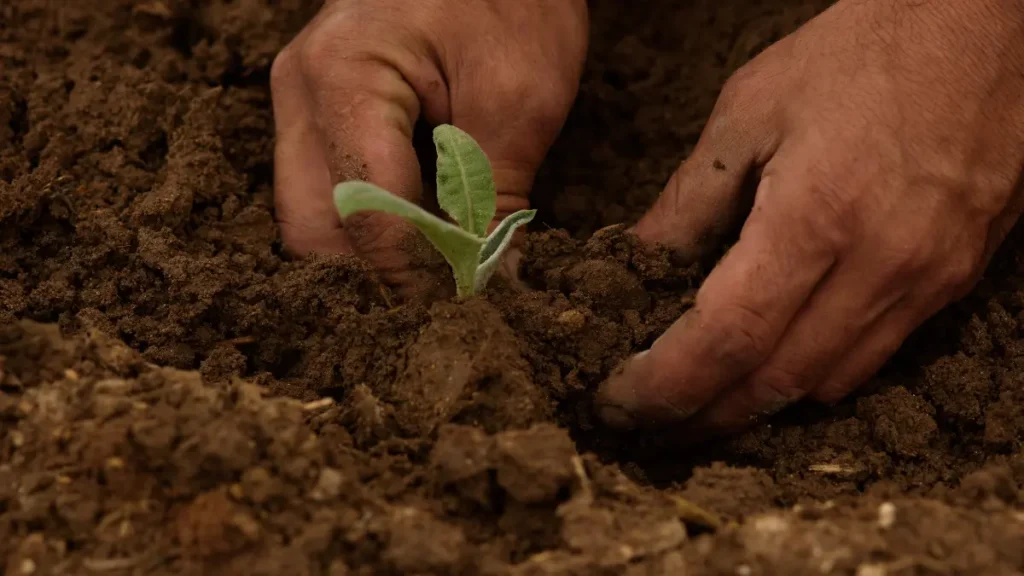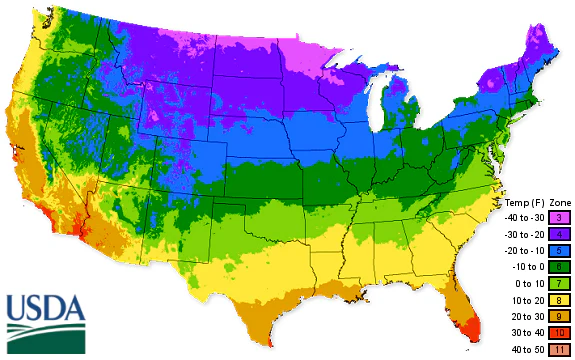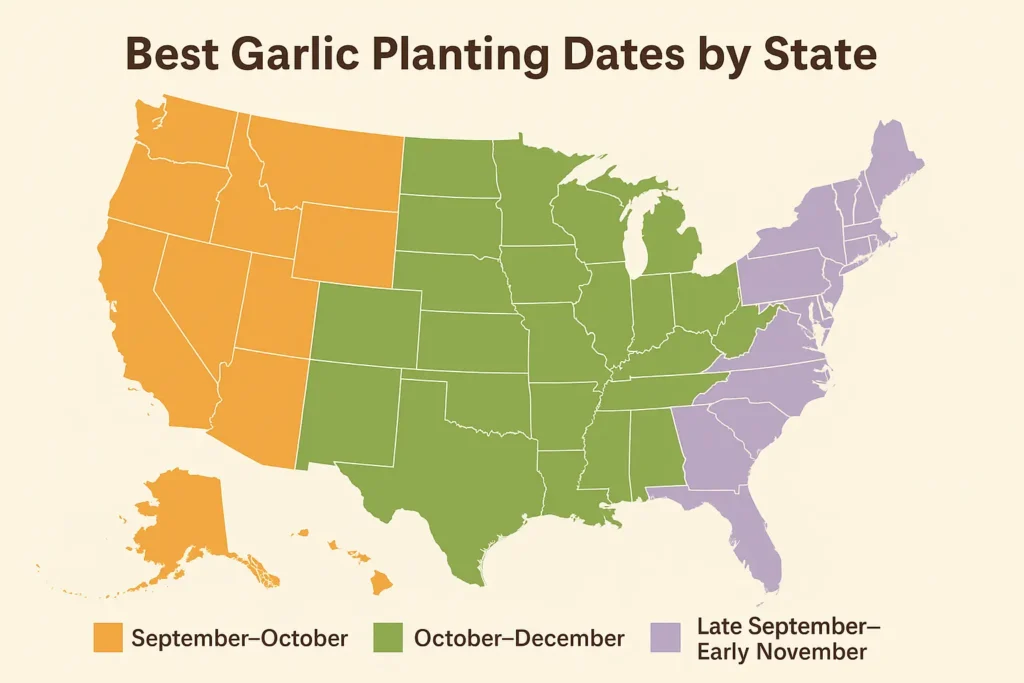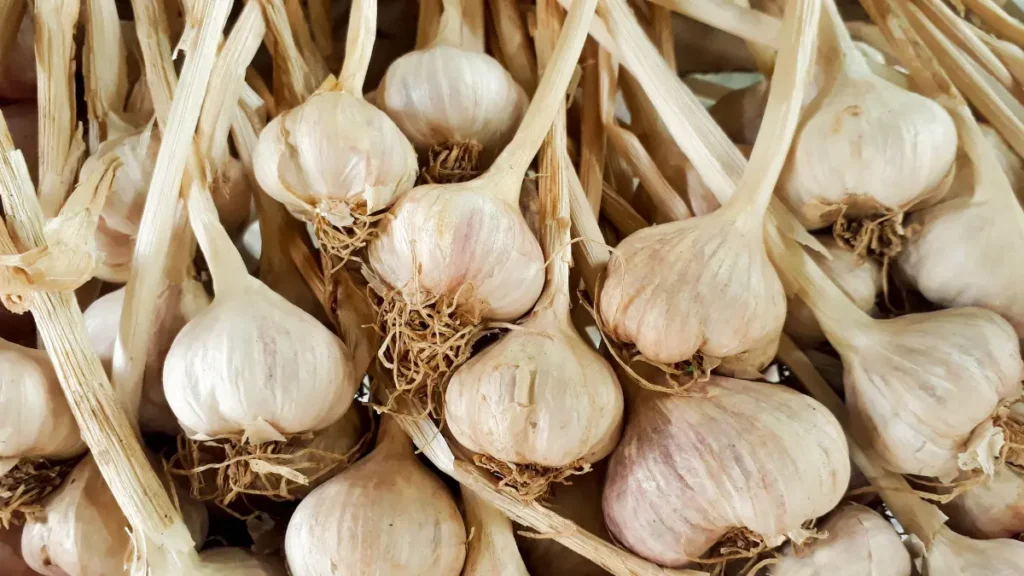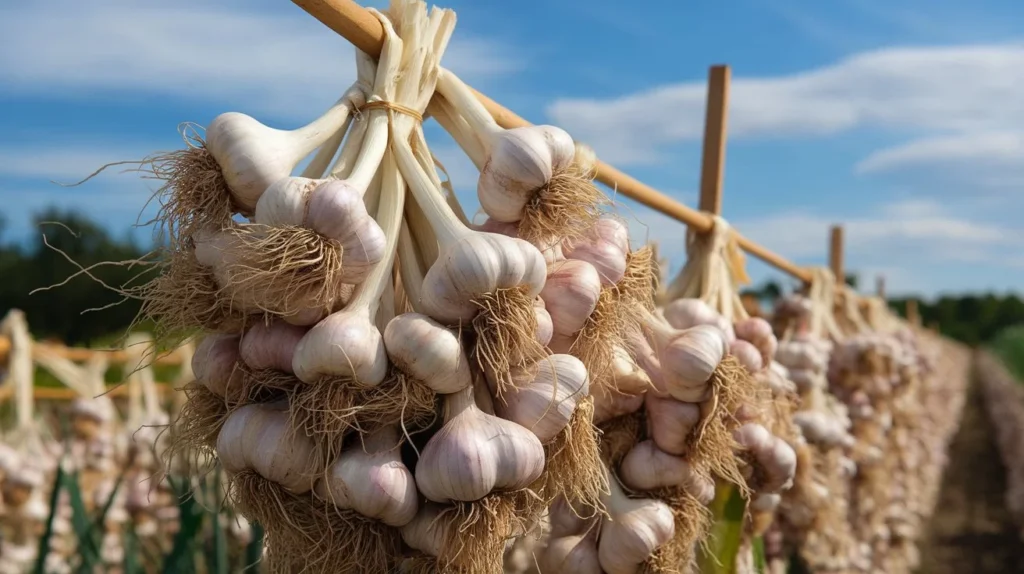When to Plant Garlic: Timing Your Garden for a Bountiful Harvest
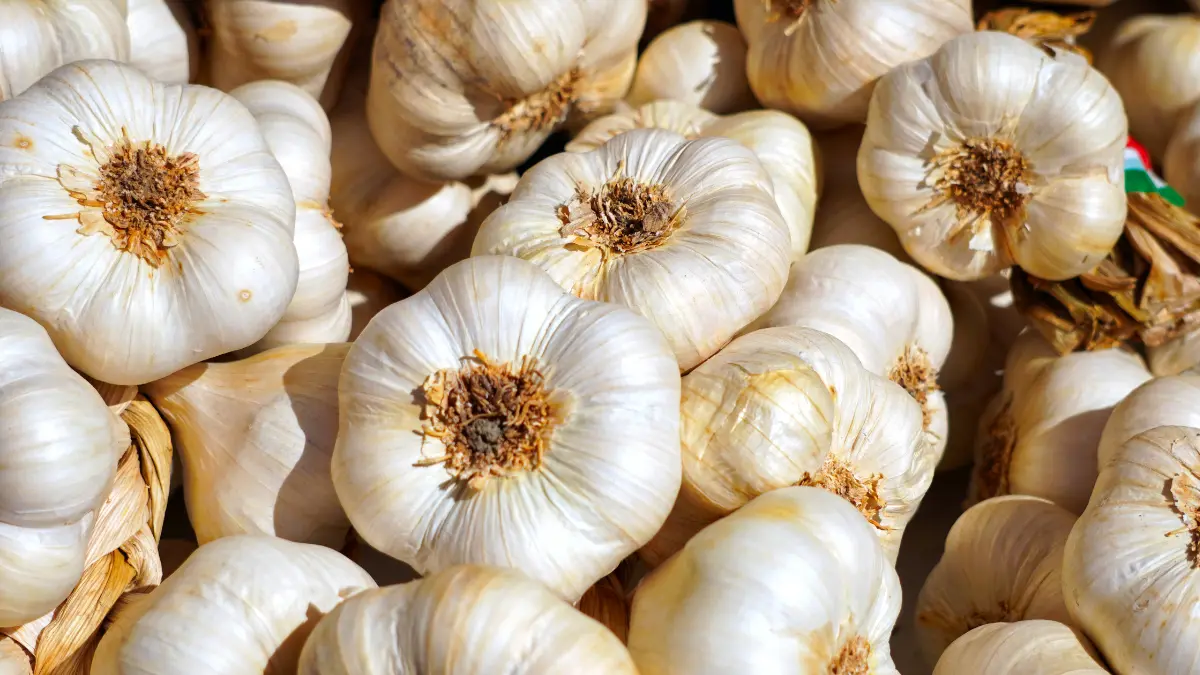
Knowing when to plant garlic is one of the simplest yet most crucial steps toward a successful crop. Whether you’re growing a small kitchen garden or planning a full seasonal harvest, timing influences everything — from bulb size to flavor intensity.
Of course, when you plant is only part of the story. How you plant garlic matters just as much. It’s tempting to think you can simply tuck cloves into the soil and forget about them, but details like depth, spacing, and soil preparation often decide whether you harvest plump, aromatic bulbs or a stunted batch.
Gardening isn’t always an exact science. Some swear by early October planting; others wait for the first light frost. There’s tradition, technique, and a little intuition involved — and that’s part of what makes growing garlic so rewarding.
In this guide, we’ll cover not only the best times to plant garlic but also how to do it right — from soil conditions to regional timing tips. Whether you’re wondering when to plant garlic in Missouri or how to time a fall planting in Zone 8, you’ll find practical advice tailored to your climate.
Table of Contents
When Is the Best Time to Plant Garlic?
Knowing when is the best time to plant garlic can make all the difference in your harvest. For most gardeners, fall planting is ideal. Garlic planted in the fall develops strong roots before winter, leading to bigger, healthier bulbs. The general rule is to plant 4 to 6 weeks before the ground freezes, usually between late September and early November, depending on where you live.
Some gardeners prefer planting after the first frost, believing it encourages quick rooting without premature sprouting. Others argue that earlier planting gives the cloves a head start. Neither approach is wrong — it often comes down to personal preference and local conditions.
Spring planting is an option too, especially in areas with harsh winters where fall planting isn’t practical. However, garlic planted in spring typically produces smaller bulbs, and timing becomes more sensitive to sudden temperature changes.
In the next sections, we’ll explore the best planting windows by zone and state to help you find your perfect timing.
Garlic Planting Guide by USDA Zones
When planning a garlic crop, understanding when to plant garlic according to your USDA zone makes all the difference between a thriving harvest and a disappointing one. Timing isn’t just about temperature—it’s about giving the garlic enough time to establish roots before winter hardens the soil. Though recommendations exist, experience shows that even within the same zone, factors like microclimates, elevation, and unexpected weather shifts can influence outcomes.
When to Plant Garlic in Zone 5
Gardeners in Zone 5 typically plant garlic between late September and early October. At first glance, it may seem a little early, especially when fall days still feel warm. But trust the rhythm of the seasons—waiting too long risks the ground freezing before the cloves develop strong roots. Some growers even gamble by planting into mid-October if the fall is unusually mild, though it can be risky. If you’re unsure, many suggest a simple rule of thumb: plant when you can comfortably wear a light jacket outside without feeling too warm.
When to Plant Garlic in Zone 6
In Zone 6, early to mid-October is generally the sweet spot. There’s a bit more flexibility here compared to colder zones, and some seasoned gardeners argue that planting later—say, closer to late October—helps prevent premature sprouting during unexpected warm spells. Others insist that earlier planting guarantees bigger bulbs come harvest time. Both perspectives hold some truth depending on the year’s weather patterns, so trust your local experience as much as any calendar.
When to Plant Garlic in Zone 7
For Zone 7, mid-October is typically ideal. This timing threads the needle between cool autumn soil and the looming threat of an early frost. Some growers, especially those at higher elevations within Zone 7, advocate for a slightly earlier start—early October—to hedge against colder snaps. Others closer to sea level may find planting even into late October still delivers good results. It’s one of those judgment calls where observation year after year becomes your best guide.
When to Plant Garlic in Zone 8
Timing garlic in Zone 8 requires a little more finesse. Most gardeners aim for late October to early November, taking advantage of the longer, warmer autumns. But not all Zone 8 areas behave the same.
For instance, those gardening in hotter Zone 8b climates often push planting into early November, while cooler Zone 8a regions may benefit from a late-October planting to avoid late-season heat stressing young cloves. There’s some debate whether waiting for the first real chill improves root establishment, but in practice, many find that simply following the soil—rather than the calendar—yields the best results. If the soil has cooled below 60°F but hasn’t frozen, it’s usually time to plant.
State-by-State Garlic Planting Calendar
Timing is everything when it comes to garlic. Yet, even among seasoned gardeners, there’s occasional debate about the “perfect” window. Some prefer to plant earlier to allow more root development, while others argue that waiting just a little longer results in stronger bulbs come harvest. Here’s a guide to when to plant garlic across the United States — use it as a baseline, but remember that local weather, soil conditions, and even instinct sometimes influence the final decision.
When to plant garlic in Missouri:
Mid to late October is usually ideal. Some gardeners swear by planting right after the first light frost, while others prefer getting cloves in the ground when soil temperatures dip consistently below 60°F.
Curious about garlic planting times in Texas? Here’s a detailed guide tailored to Texas gardeners.
When to plant garlic in Indiana:
Late September through mid-October offers the best results. Occasionally, in southern parts of the state, growers push into late October without much trouble.
Curious about garlic planting times in Indiana? Here’s a detailed guide tailored to Indian gardeners.
When to plant garlic in Georgia:
Mid-October to early November works well, especially for softneck varieties. However, in some warmer pockets, planting into late November isn’t unheard of.
When to plant garlic in North Carolina (NC):
Aim for late October. In the mountain regions, a few gardeners start earlier, sometimes mid-October, just to play it safe before sudden cold snaps.
When to plant garlic in Colorado:
Early to mid-October is best. Higher elevation gardeners often plant a bit earlier, citing unpredictable early snows.
When to plant garlic in Connecticut (CT):
Mid to late October is the typical target. Some gardeners argue for Halloween weekend as the “magic” time, while others say anytime before the ground freezes is fine.
When to plant garlic in Maine:
Late September into early October is recommended. In northern Maine, some farmers rush to get garlic in as early as mid-September, concerned about early frosts.
When to plant garlic in Texas:
Late October to November works across much of Texas. However, in southern parts of the state, December planting can succeed, especially for varieties adapted to shorter day lengths.
Curious about garlic planting times in Texas? Here’s a detailed guide tailored to Texas gardeners.
When to plant garlic in Virginia:
Mid to late October is standard. Coastal regions may extend planting into early November thanks to lingering warm soil temperatures.
When to plant garlic in Illinois:
Early to mid-October is reliable. Some gardeners in southern Illinois delay until late October, arguing that a slightly delayed planting produces a cleaner harvest.
When to plant garlic in Oklahoma:
October is the go-to month. There’s a tendency among some growers to push planting into early November if autumn remains unusually warm.
When to plant garlic in Ohio:
Mid-October is ideal. That said, a few experienced growers have claimed success even when planting in early November, especially in milder years.
When to plant garlic in Minnesota:
Late September to early October gives garlic enough time before the soil locks up. Northern Minnesota gardeners might even aim for mid-September during colder years.
When to plant garlic in Wisconsin:
Early to mid-October is recommended. Some farmers risk a later planting in southern Wisconsin, relying on heavy mulch to protect young shoots.
When to plant garlic in Tennessee:
Mid to late October fits most areas. In warmer zones near Memphis, it’s not unusual to see planting well into early November.
When to plant garlic in Oregon:
Late September through October is garlic season. West of the Cascades, some gardeners plant into early November, trusting the milder maritime influence.
When to plant garlic in New York (NY):
Early to mid-October is the sweet spot. Upstate growers often rush earlier due to colder weather, while those closer to the coast have a bit more flexibility.
When to plant garlic in Massachusetts:
Mid to late October is standard. Interestingly, some New England gardeners say planting after the first hard frost leads to the best bulbs — others prefer a slightly earlier schedule to avoid frozen soil.
When to plant garlic in Michigan:
Early to mid-October is typically recommended. Northern Michigan tends to see garlic in the ground even earlier, by late September.
When to plant garlic in Florida:
Late October through November is advised for North Florida. In South Florida, garlic growing is tricky — and some insist it’s better to skip planting altogether unless you’re experimenting with tropical varieties.
When to plant garlic in New Jersey (NJ):
Mid-October is a good target. However, urban gardeners closer to coastal areas sometimes get away with planting into early November.
When to plant garlic in Pennsylvania (PA):
Mid to late October works well. As always, colder regions near the Allegheny Mountains tend to plant a little earlier compared to milder Philadelphia suburbs.
When to plant garlic on the Gulf Coast:
November is a safe bet. Still, the Gulf Coast’s mild winters allow some adventurous gardeners to push planting into December with reasonable success.
How to Plant Garlic (Step-by-Step)
Planting garlic may seem straightforward at first, but the way you handle the cloves, the depth you plant them, and even the season you choose can shape your final harvest more than you might expect. Whether you’re working with seeds, bulbils, or traditional cloves, mastering these steps can mean the difference between small, spindly bulbs and the hefty, aromatic heads you dream of pulling from the soil.
How to Separate Garlic Cloves for Planting?
Before you plant, it’s essential to properly separate the garlic cloves. Start by choosing healthy, firm bulbs — ones that feel heavy for their size and show no signs of mold or shriveling. Gently twist the bulb to loosen the cloves. Some gardeners swear by using their fingers only, believing that tools bruise the cloves, while others argue that a gentle pull with a small paring knife causes less overall damage.
In reality, both methods work if done carefully. The important part is preserving the papery skin around each clove, which protects it against soilborne diseases. Some growers are meticulous about selecting only the largest cloves for planting, assuming bigger cloves will always produce bigger bulbs. Others embrace a mix, noting that even small cloves can surprise you with robust growth under the right conditions.
How Deep to Plant Garlic?
Depth is one of the most debated aspects of garlic planting. Most experts recommend planting cloves about 2 to 3 inches deep, measuring from the tip of the clove to the soil surface. This depth protects the cloves from freezing in colder climates while giving roots enough room to anchor firmly.
However, some growers in milder regions argue that planting too deeply can delay sprouting in the spring, and they stick closer to 2 inches — just enough to cover the clove and mulch heavily afterward. Like many things in gardening, it often comes down to your soil type, local winter temperatures, and personal experience.
How Far Apart Do You Plant Garlic?
Spacing matters more than you might think. Garlic cloves should generally be planted 4 to 6 inches apart in rows spaced about 12 inches apart. This distance allows each plant enough room to grow without competing for nutrients, water, or sunlight. Calculate optimal garlic plant spacing using our calculator.
Still, gardeners with limited space often tighten the gaps, planting 3–4 inches apart and relying on extra compost and careful watering to compensate. It works, sometimes — but closer spacing can lead to smaller bulbs if conditions aren’t ideal. On the other hand, overly wide spacing isn’t necessarily better either. Garlic plants don’t love isolation; they seem to do better when grouped modestly together.
How to Plant Garlic in Pots?
Growing garlic in pots is an excellent option for anyone short on garden space. Choose a container at least 10–12 inches deep and wide enough to accommodate multiple cloves spaced 4–5 inches apart.
Fill the pot with rich, well-draining soil amended with compost. Plant each clove pointed side up, just as you would in the ground, about 2–3 inches deep. Potted garlic dries out faster than garden-grown garlic, so keep a closer eye on watering — the soil should stay evenly moist, not soggy. Some gardeners insist that potted garlic doesn’t reach the same size as ground-grown bulbs, while others say that with good soil and a sunny spot, the difference is barely noticeable. Estimate water needs for your garlic crop using our Irrigation Water Requirement Calculator.
How to Plant Garlic in the Fall?
Fall planting is generally considered the best time to plant garlic. The cool temperatures encourage strong root development before the ground freezes, leading to larger, more robust bulbs by summer.
Plant garlic 4–6 weeks before your first hard frost. After planting, apply a thick layer of mulch — about 3–4 inches — to protect the cloves through winter. Some people skip the mulch, especially in milder regions, but this can risk heaving (where bulbs are pushed out of the soil during freeze-thaw cycles).
Interestingly, a few gardeners prefer lighter mulching, arguing that heavy mulch leads to moisture buildup and fungal problems in wet winters. Like many aspects of gardening, it’s a balance you’ll learn through trial and error.
How to Plant Garlic in the Spring?
If fall planting isn’t an option, garlic can be planted in early spring as soon as the ground is workable. Spring-planted garlic generally produces smaller bulbs because it misses out on winter dormancy, but the flavor remains rich and complex.
Use the same planting technique: separate cloves, plant 2–3 inches deep, and mulch lightly. Some spring growers start cloves indoors during late winter, harden them off, and then transplant outside for a slight head start — though results vary based on climate and garlic variety.
How to Plant Sprouted Garlic Cloves?
If you’ve ever left garlic in your pantry too long and noticed green shoots poking out, you’re in luck — sprouted garlic cloves can be planted too. Treat them gently, as sprouts are delicate.
Plant sprouted cloves the same way as unsprouted ones, with the shoot upright and the clove 2–3 inches beneath the surface. Some believe sprouted garlic grows slightly slower at first, while others claim the initial green boost actually jumpstarts the plant’s energy.
In truth, both outcomes happen depending on how robust the sprout is and how quickly the plant adapts to outdoor conditions.
How to Plant Garlic Seeds and Bulbils?
Planting garlic from true seeds or bulbils (small aerial cloves that form on the scape) is a longer process. Unlike cloves, seeds and bulbils typically take two seasons to develop into full-sized bulbs.
Sow bulbils or seeds shallowly — about ½ inch deep — in a nursery bed or pots. Let them grow through the first year, then dig up and replant the tiny rounds in the fall to mature the following summer.
Some gardeners find growing from bulbils deeply rewarding, citing improved disease resistance. Others find the process tedious compared to simply planting cloves. Both perspectives are valid — patience plays a big role in deciding whether to try it.
Knowing when to plant garlic is just the first step. If you’re looking for a complete walkthrough on how to prep soil, plant cloves, manage growth, and harvest like a pro, check out our full guide on how to grow garlic. It’s packed with step-by-step instructions and proven tips to take your garlic crop from planning to plate.
How to Plant Elephant Garlic?
Though it’s called “garlic,” elephant garlic is technically a type of leek — but it’s grown much like garlic.
Plant elephant garlic cloves 4–6 inches deep and space them 6–8 inches apart because they grow much larger than standard garlic. Some growers mulch heavily to maintain consistent moisture, while others caution that excessive mulching can lead to rot if your soil doesn’t drain well.
Unlike traditional garlic, elephant garlic can sometimes produce large bulbs even from relatively small cloves — a happy contradiction that makes it a favorite for gardeners who love a good surprise.
Predict your garlic harvest yield using our vegetable yield calculator.
Companion Planting and Garlic Care Tips
Garlic Companion Planting Guide
✅ Good Companions
- Carrots
- Beets
- Kale
- Spinach
- Tomatoes
- Peppers
- Broccoli
- Cabbage
- Fruit trees (natural pest repellent)
- Roses (protects from aphids)
🚫 Bad Companions
- Beans
- Peas
- Sage
- Asparagus
- Strawberries
- Parsley
- Rue
When planning a garlic bed, it’s tempting to think solely about soil quality or sun exposure. But one of the most overlooked strategies for a healthier, more productive garden is companion planting. Choosing the right plants to grow alongside garlic can quietly boost your harvest, while the wrong ones might leave you wondering why things didn’t turn out quite as you hoped.
Garlic is surprisingly sociable in the garden — at least with the right crowd. It has natural pest-repelling properties that benefit many vegetables, making it an excellent neighbor in mixed beds.
If you’re wondering what to plant garlic with, some tried-and-true favorites are carrots, tomatoes, and beets. Gardeners often notice that carrots grown near garlic have better root development, perhaps because garlic’s scent helps deter root maggots and other pests. Tomatoes seem to appreciate garlic’s pest-repelling qualities too, though some growers say the benefit feels subtle — maybe it’s more about keeping aphids and spider mites slightly at bay than achieving dramatic results. Beets, on the other hand, are often cited as reliable companions because they happily coexist without competing for nutrients.
Yet, not everything gets along perfectly with garlic. It’s generally advised to avoid planting garlic near peas and beans. Both are legumes that fix nitrogen in the soil, and there’s a theory — not universally agreed upon — that garlic’s sulfur compounds may interfere with that process. Some gardeners report that beans look stunted or less vigorous when garlic is planted nearby, while others claim they’ve had no obvious issues. Perhaps it depends on the soil richness, the specific bean variety, or just luck.
When designing your garlic bed, think not just about individual plants, but about building a supportive community underground and above. A little planning here can ripple through your entire garden season.
When and How to Harvest Garlic
Garlic planted in the fall typically takes about 8 to 9 months to mature. If you planted garlic in October, you can usually expect to harvest it by early to mid-summer, depending on your climate. However, seasons are rarely predictable. A cool spring might delay maturity, while a warm, fast start could push harvest a few weeks earlier.
A simple way to judge when to harvest garlic is by looking at the leaves. When about five green leaves are still standing, it’s often the right time to dig up the bulbs. Each green leaf represents a layer of protective skin around the bulb. Some gardeners wait until just three leaves remain for tighter wrappers, but this carries the risk of bulbs starting to split or lose quality. It’s a fine balance between patience and caution.
If you’re wondering how long to grow a garlic plant, the timeline rarely feels exact. Most varieties mature after 8–9 months, yet small local differences—like unexpected rain or heat waves—can shift things slightly.
After harvesting, curing the garlic is essential. Spread the bulbs out in a dry, shaded, and airy space for about two to three weeks. Avoid direct sun, which can overheat and damage the bulbs. When the outer skins are papery and the stems fully dry, your garlic is ready for storage—or for savoring sooner if you can’t resist.
Common Questions About Planting Garlic
Garlic is surprisingly versatile to grow, but depending on how you start — seeds, cloves, bulbils, or even sprouts — the method can slightly change. Below are straightforward answers to some of the most common garlic planting questions, balancing practical advice with the slight ambiguity that often comes with real-world gardening.
How do you plant garlic seeds?
Garlic seeds, when available, are planted much like tiny onion seeds. Sow them shallowly, about ¼ inch deep, in loose, fertile soil. They can take longer to mature into full bulbs — often needing an extra season — which is why many gardeners prefer cloves instead. Still, growing from seed has its charm if you’re patient.
How do you plant elephant garlic?
Plant elephant garlic cloves 4–6 inches deep and 8 inches apart, leaving extra space because of their size. Some growers treat it just like regular garlic, while others believe it benefits from even richer soil. Results can vary — a few gardeners notice elephant garlic grows more like a mild leek if conditions aren’t perfect.
How to plant garlic scapes?
Garlic scapes aren’t planted — they’re harvested. Scapes are the flowering shoots that hardneck garlic produces. They should be trimmed when they curl to encourage bigger bulb growth. That said, some people have experimented with replanting scape bases in moist soil, though it rarely leads to bulb formation.
How to plant garlic sprouts?
If your garlic cloves have sprouted before planting, don’t throw them away. Simply plant the clove with the green shoot pointing upward, about 2 inches deep. Some gardeners believe sprouted cloves lead to weaker bulbs, while others have seen perfectly healthy harvests — it largely depends on soil health and timing.
How to plant garlic chives?
Plant garlic chive seeds about ¼ inch deep in well-draining soil during early spring or fall. Garlic chives grow more for their flavorful leaves than bulbs, making them a different experience altogether. Some people direct sow, while others prefer starting them indoors for stronger seedlings.
How to plant a sprouted garlic clove?
Handle the sprouted clove carefully, as the green shoot is delicate. Plant it root-end down, with the sprout just below or barely at soil level. There’s mild debate: some believe sprouted cloves grow slower, others argue they catch up by harvest time if planted early enough in spring.
Conclusion: Mastering Garlic Growing Year-Round
Growing garlic might seem simple at first glance—plant a clove, wait, harvest—but timing and technique can make all the difference between a harvest of plump, aromatic bulbs and a basket of disappointing, undersized ones. Understanding when to plant garlic based on your local climate is truly the foundation of success.
For most gardeners, fall planting offers the greatest rewards. When garlic goes into the ground in autumn, the cloves spend the winter months developing strong roots beneath the surface, quietly preparing for a vigorous spring growth. But then again, spring planting has its place too. Some gardeners, especially in areas with harsh winters or unpredictable falls, prefer spring planting, accepting slightly smaller bulbs in exchange for a more controlled start. There’s no perfect answer — a lot depends on your personal climate, soil conditions, and even a bit of luck.
Generally speaking, in zones 5 and 6, planting garlic from late September through October gives the best results. Gardeners in zone 7 or 8 often wait until mid-to-late October, or even early November in warmer pockets. Meanwhile, if you live somewhere like Texas or along the Gulf Coast, you might find that garlic thrives best with a later planting window, when the worst of the summer heat has finally passed.
Each state and zone carries its own quirks. For example, in Ohio and Pennsylvania, sudden early frosts might push you to plant a week earlier than planned, while in Florida, garlic growers must be careful to choose the right variety and monitor winter warmth closely. Even seasoned gardeners sometimes debate the exact timing, finding that what worked perfectly one year fails them the next. Nature rarely reads the same calendar we do.
That’s why it’s essential to stay flexible. Pay attention not just to the date, but to the soil itself. Garlic prefers cool, moist earth—not frozen ground, but not summer-warm soil either. A few degrees’ difference at planting can influence your entire harvest season. Some experienced growers even advise adjusting your planting date each year based on the feel of the soil rather than the calendar alone.
No matter where you garden, remember that planting garlic at the right time for your state or zone is only part of the equation. How you plant—depth, spacing, soil preparation—matters just as much. But don’t be intimidated. Even mistakes often produce usable garlic, and every season teaches something new.
If you’re looking for more detailed planting calendars or crop care tips, feel free to explore our other guides like [How to Prepare Soil for Fall Planting] or [The Best Companion Plants for Garlic]. These resources dive deeper into building a strong garden foundation that supports healthy, productive crops year after year.
In the end, growing garlic is as much about patience as it is about planning. Whether you follow the “rules” closely or adapt them slightly each season, the simple act of planting a clove and nurturing it through the months ahead is a quiet triumph of hope—and, often enough, a delicious reward.

